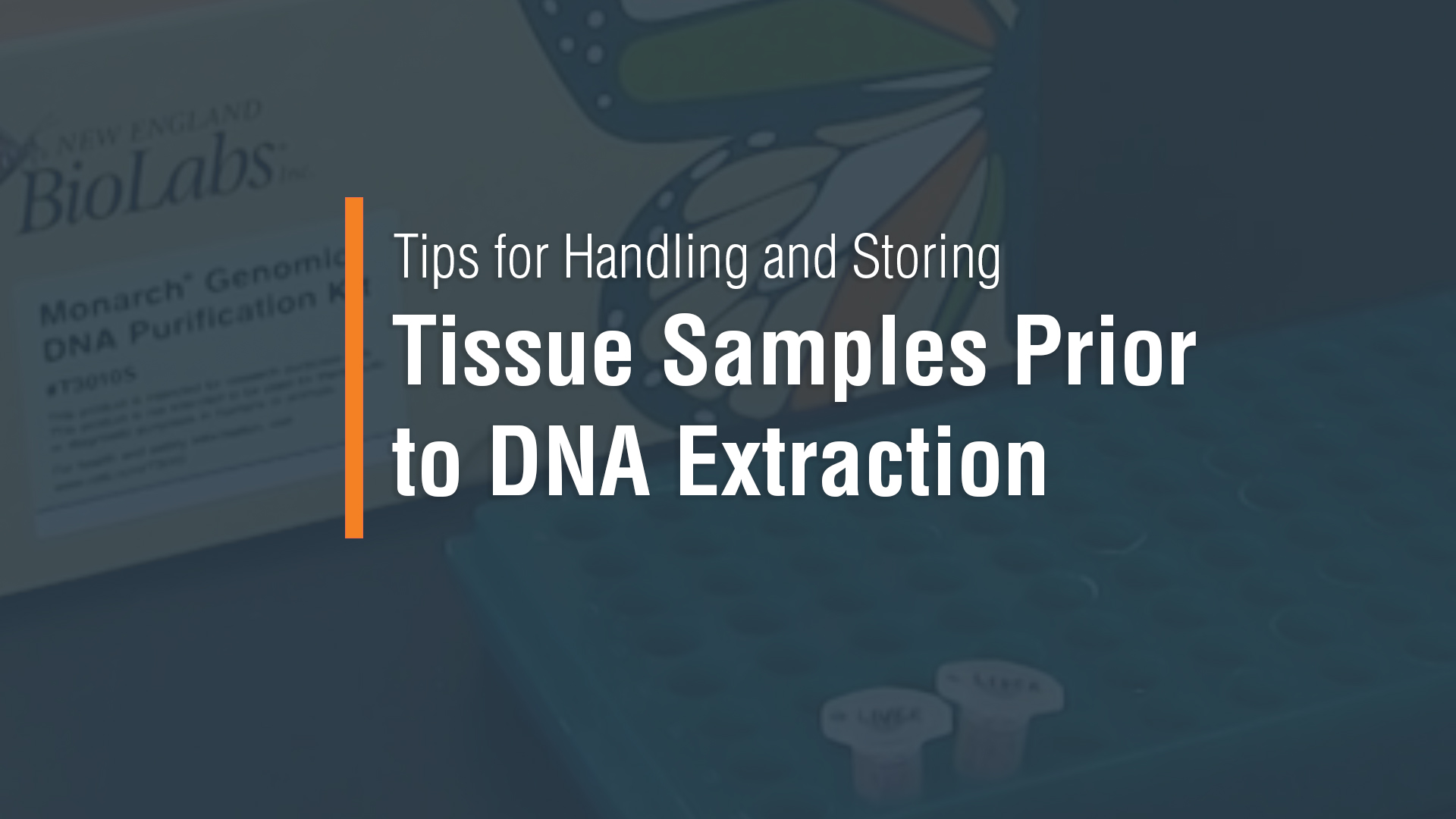Protocol for Genomic DNA Extraction from Tissue Samples Stabilized with Monarch® DNA/RNA Protection Reagent (NEB #T2011) using the Monarch Genomic DNA Purification Kit (NEB #T3010)
Overview
This protocol enables the genomic DNA extraction from tissue samples
Materials
- Microtube pestle and matching tube, e.g., Monarch Pestle Set (NEB #T3000L)
- Monarch DNA/RNA Protection Reagent (NEB #T2011)
Before You Begin
- Store RNase A and Proteinase K at -20°C.
- Add ethanol (≥ 95%) to the Monarch gDNA Wash Buffer concentrate as indicated on the bottle label.
- Set a thermal mixer (e.g., ThermoMixer® or similar device), or a heating block to 56°C for sample lysis.
- Set a heating block to 60°C. Preheat the appropriate volume of elution buffer to 60°C (35–100 μl per sample). Confirm the temperature, as temperatures are often lower than indicated on the device.
- Do not load a single column with the lysed sample more than once; over-exposure of the matrix to the lysed sample can cause the membrane to expand and dislodge.
Sample stabilization:
- Prepare a 2x dilution of DNA/RNA Protection Reagent by mixing 1 part DNA/RNA Protection Reagent with 1 part nuclease-free water.
- Weigh the appropriate tissue amount and place in the 1.5 ml pestle tube (see table below for recommended input amounts). Using more than the recommended amounts will not lead to better yields and/or purity.
- Add 100 µl of the 2x diluted DNA/RNA Protection Reagent to the tissue piece and mix by vortexing briefly.
STARTING MATERIAL
RECOMMENDED INPUT AMOUNT
Brain
Up to 12 mg
Fibrous tissue (muscle, heart, rodent tail)
Up to 25 mg
Ear clips, skin
Up to 10 mg
Liver, lung
Up to 15 mg
Spleen, kidney
Up to 10 mg
Sample storage:
- Long-term storage (> 30 days): Use of freezers at –20 or –80°C is recommended.
- Medium-term storage (1-4 weeks): Refrigeration can be used.
- Short-term storage (< 7 days): Samples may be stored at 20-25°C.
Genomic DNA Purification Consists of Two Stages:
PART 2: Genomic DNA Binding and Elution
- Thoroughly homogenize the tissue sample using the microtube pestle. Due to the denaturing properties of the protection reagent, the Proteinase K activity in the lysate will be significantly lower than in Tissue Lysis Buffer alone. For complete release of the genomic DNA, thorough homogenization of the tissue is required.
- Add 10 μl Proteinase K and 200 μl of Tissue Lysis Buffer and mix by vortexing. Incubate for a minimum of 45 minutes at 56°C in a thermal mixer with agitation at full speed (1400 rpm or 2000 rpm if available). If a thermal mixer is not available, vortex samples several times during incubation, especially in the first minutes of lysis. Additionally, vortex continuously for 1 minute at the end of the incubation.
- Optional:After 30 minutes of lysis, add another aliquot of 10 µl Proteinase K for more complete lysis of the tissue material.
- Add 3 µl RNase A and incubate for 10 minutes at 56°C in a thermal mixer with agitation at full speed (1400 rpm or 2000 rpm if available). If a thermal mixer is not available, vortex samples a few times during incubation.
- Centrifuge the lysate for 2 minutes at 16,000 xg to remove debris. Transfer supernatant to a new 1.5 ml tube (not provided). At the end of lysis, the lysate will look slightly hazy due to the presence of fine residual tissue particles. These should be removed by centrifugation before adding Binding Buffer and column loading.
- Proceed to Step 1 of Part 2: Genomic DNA Binding and Elution.
Part 2: Genomic DNA binding and elution
- Add 400 μl gDNA Binding Buffer to the sample and mix thoroughly by pulse-vortexing for 5-10 seconds. Thorough mixing is essential for optimal results.
- Transfer the lysate/binding buffer mix (~700 μl) to a gDNA Purification Column pre-inserted into a collection tube, without touching the upper column area. Do not transfer any foam. Proceed immediately to step 3. Do not reload the same column with more sample; over-exposure of the matrix to the lysed sample can cause the membrane to expand and dislodge.
Any material that touches the upper area of the column, including foam, may lead to salt contamination in the eluate.
- Close the cap and centrifuge: first for 3 minutes at 2,000 x g to bind gDNA (no need to empty the collection tubes or remove from centrifuge) and then for 1 minute at maximum speed (> 12,000 x g) to clear the membrane. Discard the flow-through and the collection tube. For optimal results, ensure that the spin column is placed in the centrifuge in the same orientation at each spin step (for example, always with the hinge pointing to the outside of the centrifuge); ensuring the liquid follows the same path through the membrane for binding and elution can slightly improve yield and consistency.
- Transfer column to a new collection tube and add 500 μl gDNA Wash Buffer. Close the cap and invert a few times, so that the wash buffer reaches the cap. Centrifuge immediately for 1 minute at maximum speed (12,000 x g), and discard the flow through. The collection tube can be tapped on a paper towel to remove any residual buffer before reusing it in the next step. Inverting the spin column containing wash buffer prevents salt contamination in the eluate.
- Reinsert the column into the collection tube. Add 500 μl gDNA Wash Buffer and close the cap. Centrifuge immediately for 1 minute at maximum speed (>12,000 x g), then discard the collection tube and flow through.
- Place the gDNA Purification Column in a DNase-free 1.5 ml microfuge tube (not included). Add 35-100 μl preheated (60°C) gDNA Elution Buffer, close the cap and incubate at 60°C for 5 minutes. Elution in 100 μl is recommended, but smaller volumes can be used and will result in more concentrated DNA but a reduced yield (20–25% reduction when using 35 μl). Eluting with preheated elution buffer will increase yields by ~20–40% and eliminates the need for a second elution. For applications in which a high DNA concentration is required, using a small elution volume and then eluting again with the eluate may increase yield (~10%). Incubation at 60°C for 5 minutes will give higher yields as it helps elute a larger proportion of the tough-to-elute long gDNA fragments. The elution buffer (10 mM Tris-Cl, pH 9.0, 0.1 mM EDTA) offers strong protection against enzymatic degradation and is optimal for long term storage of DNA. However, other low-salt buffers or nuclease-free water can be used if preferred. For more details on optimizing elution, please refer to “Considerations for Elution & Storage” in the product manual.
- Centrifuge for 1 minute at maximum speed (> 12,000 x g) to elute the gDNA. Discard spin column and close cap. Vortex eluate briefly for homogeneity.

